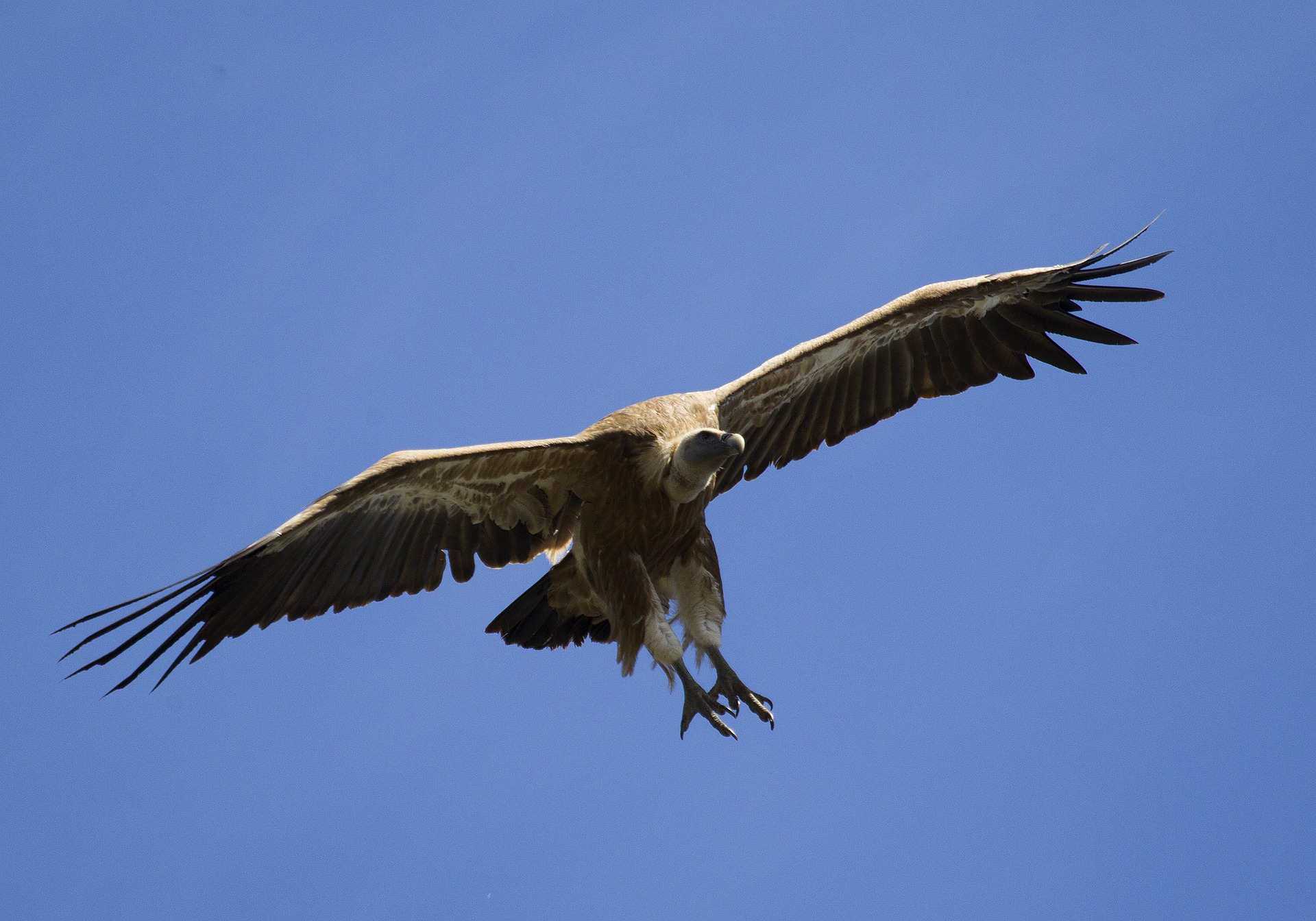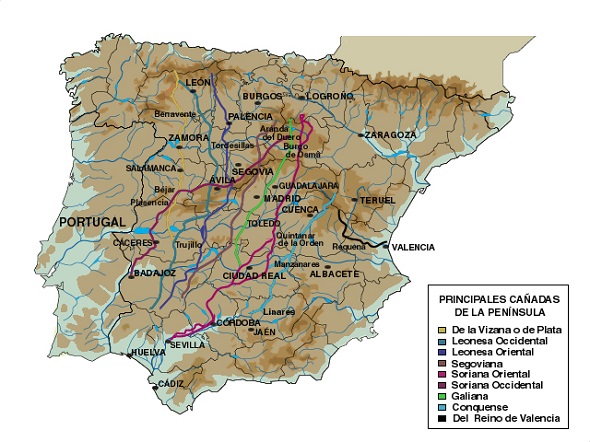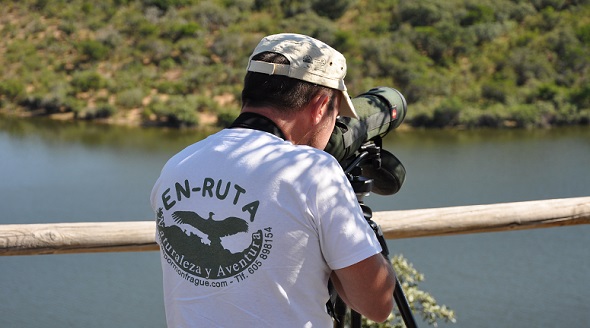The Monfragüe National Park in Extremadura is a haven for birdwatchers and nature lovers alike. It consists of over 17,000 hectares of land made up of wide-open expanses of both woodland and dry pastures, as well as numerous rocky areas and oak trees. The park is most famous for its collection of Black Vultures, with more than two hundred pairs and the Spanish Imperial Eagle of which it has ten couples making Monfrague the world’s biggest colony for both these birds. Black storks are the other most rare species in the park. Because of the migratory habits of these birds the best time to visit Monfragüe is between March and October.
Monfragüe National Park is also home to some of the more common birds of prey including Griffon Vultures, Egyptian Vultures, Peregrine Falcons and Golden Eagles. A variety of harriers and kites also feature amongst the estimated 175 different types of birds that frequent the par.
Despite the fact that the Monfragüe National Park is best known for its bird life there is plenty more wildlife to look out for. Some of the other types of animals that you’ll encounter on your journey through the park include wild boar, otters and Iberian lynxes, which are very rare. Add to this wild cats and a mix of red, fallow and roe deer and the park is a wonderful place to visit for nature lovers.

The park provides a fine education service which includes a Water Protection Centre, a Nature Centre and the main Visitor center. Here you can learn about all the park’s inhabitants through interesting multimedia shows that even children will find it interesting.
It’s not just the wildlife that Monfragüe National Park offers the visitor either. If you take a visit to the Castillo cave you’ll be able to look at some drawings made by the earliest cavemen of the region. As well as this, there is also the 9th century Castillo de Monfrague which was a Moorish fort which today serves as a great spot for birdwatching.
Where is Monfragüe National Park?
Located 60km north-east of Cáceres in the western region of Extremadura, Monfragüe National Park is easy to reach by road from as far away as Madrid or even Portugal.
Our Excursion in Monfragüe National Park
Our half day tour began at the Monfragüe campsite at 9am where our tour guide Alberto from En-Ruta collected us in his 4×4 Nissan. The tone of the trip was soon set as we headed for our first viewing point situated just beyond the small village of Villarreal de San Carlos as Alberto began pointing out interesting aspects of local flora and fauna. Over to our right a group of eucalyptus trees stood out from the rest. Apparently they were imported from Australia with a view to creating paper during the Franco era. As a result they caused the soil to dry out and acidify.
Nowadays few remain as the local environmental agency has carried out a major reforestation project replacing eucalyptus with native oak trees. Unfortunately, only one in twenty-five of these young trees survive due to poor soil, deer and rabbits. The response has been to overcompensate by planting vast expanses of these young trees in an attempt to allow the maximum number to survive.
Cañadas Reales de España
We stopped overlooking the submerged Puente del Cardenal which crosses the Tajo river and dates back to 1450 when construction began so as to allow the seasonal shifting of cattle between Plasencia and Trujillo. Alberto told us that there are somewhere in the region of 125,000 km of “cañadas” (cattle tracks) in Spain which are of fixed width and are legally protected. An interesting anectdote comes from Madrid where once a year the city’s main artery road, Paseo de la Castellana, is invaded by sheep as a reminder that a cañada still runs through the capital.

The nine main cañadas shown on the above map are as follows:
- Cañada de la Vizana o de la Plata (500km)
- Cañada Leonesa Occidental (700km)
- Cañada Leonesa Oriental (700km)
- Cañada Segoviana (500km)
- Cañada Soriana Occidental (500km)
- Cañada Soriana Oriental (800km)
- Cañada Riojana o Galiana (400km)
- Cañada Conquense (350km)
- Cañada del Reino de Valencia (250km)
Birdwatching in Monfragüe
As we chatted with Alberto about such environmental issues he pointed out a number of Griffon vultures looking down on us from the rocks on the other side of the road. He then spotted a pair of black vultures circling the reservoir high above us. Apparently Monfragüe is home to the world’s largest colony of these birds with over 200 pairs living there.
Our next stop was at an impressive cliff gorge known as ‘El Salto del Gitano’ (Gipsy’s Leap) which is a fabulous spot for birwatching, especially when your guide knows exactly where to look! After watching countless pairs of Griffon vultures out came the big telescope which Alberto focused on a fixed point where we could see a black stork’s nest with two young birds inside. Then he spotted an Egyptian vulture nearby. Now I’m no birdwatcher but I’m pretty sure this was all pretty impressive and was enough to convince me to buy some decent binoculars once I got home.
Local naturalists are extremely concerned about insane plans by the regional government of Extremadura to introduce boat trips on the Tajo. In the short term this may allow tourists to get closer to the birdlife but ultimately the birds will leave and so will the tourists. Talk about killing the goose that lays the golden egg!

Back in Villarreal de San Carlos, Alberto pointed out the mini-vineyard which produces ample wine to serve the eight full-time inhabitants of this tiny settlement which serves as the information centre of the Monfragüe National Park. he says the inhabitants are a very happy bunch ;-). This would be a nice place to stay in one of the ‘Casas Rurales’ which are available to rent for a few days at a time. It’s an ideal base from which do quite a few great walks.
Dehesas de Monfragüe
I had understood that the ‘dehesa’ simply referred to the grazing land of Monfragüe but listening to the words of our local expert I soon learned that it is much more complex than that as it represents a delicate pastoral ecosystem. For instance, in the dehesa all animals are free to roam around in the wild. When they die their carcass cannot be removed as it becomes food for the vultures.
An interesting observation regarding this ecosystem … when there was an outbreak of mad cow disease in the UK the animal carcasses in Monfragüe had to be burnt and vultures were fed at special feeding areas. As a result of this guaranteed food supply the vultures gave up flying as there was no longer any need to do so!
Crossing the golden dehesa we spotted an area of perfect, green grass which Alberto explained was being grown specially for the football pitch at Atlético Madrid’s football stadium. A little further on we spotted evidence of cork farming which resulted in another interesting story:
The first time that cork can be harvested from a tree is thirty years after the tree is planted and the cork will not be any good. Ten years later is the second harvest when the cork will again be of no value because it will be too porous. Harvest number three after another ten years will be the first valuable one. From then onwards there will be a harvest every ten years. Fortunately these cork oak trees live for around 700 years.
Bullfighting and Cigarettes
Now there’s a headline I bet you’ve never seen elsewhere! Nowadays it’s difficult to broach the subject of bullfighting without incurring the wrath of animal rights campaigners so I was most impressed by Alberto’s matter of fact explanation of how the banning of bullfighting will result in the extinction of the ‘toro bravo’ bulls which roam around freely in the best sectors of the dehesa.
The survival of the ecosystem of Spain’s dehesas depends on these bulls. Their demise would result in the loss of around half a million acres of high quality pasture land in the country which would lead to serious environmental consequences. In addition, in a region such as Extremadura where unemployment is already at more than 30% thousands more jobs would be lost in rural areas.

If your Spanish is up to it there are a couple of interesting articles from the Spanish media regarding the importance of these bulls to Spain’s farmland:
- El toro bravo, guardián de la dehesa ibérica (ABC)
- El toro bravo, entre ecología y disfrute (El País)
The smoking ban in Spanish bars has already hit the local economy as it led to the closure of a local tobacco factory leaving hundreds of workers out of work and with little hope of finding alternative employment.
As well as what I’ve mentioned above we spotted a wild boar (jabalí) with her four young together with numerous deer around the park. We learned of attempts to reintroduce the Iberian Lynx into the park and how local paprika (Pimentón de la Vera) is produced. In my travels around the world I’ve been on many day and half day excursions and this certainly ranks as one of the best ever (the worst was in Cambodia but that’s another story!). If you’re ever in the park don’t hesitate to treat yourself to a few hours with one of these great local guides.
Where to Stay near Monfragüe
If you’re camping then you can’t beat the excellent Camping Monfrague. Otherwise you can rent chalets in the nearby village of Jaraicejo.

very interesting, the people in Extremadura are always pleasant and helpful. I went there many years ago with my partner as he could drive whereas I do not.
Hi Vanessa
We also found the locals in Extremadura so very friendly. Lovely people.
Thanks
Gerry
I have visited Monfrague and, like you, was thrilled to find a Black Stork’s nest with young.This was pure chance and I realise that the services of a professional guide would make the experience far more satisfying and enjoyable. Are any of the guides English-speaking? Whilst able to translate the written word a little I find fast-spoken Spanish more difficult to understand..!!
Hi Wyn
Alberto spoke English very well and I’m sure his colleagues will do also. He knew most of the bird names in English and even some of them in Dutch for the one man from Holland who was in our group of five people. Quite a bargain at about €25 per person.
Regards
Gerry
Wonderful suggestion! Have put it in our 2014 itinerary!
Several years ago I attended a Vaughantown program in Monfrague. While there we were able to see some of the landscape. Gypsy’s Leap, with the river below and the vultures flying above was certainly worth seeing. One note: A tourist bus was there when we arrived. No birds were flying. But, when we arrived in an automobile, and the bus left, the birds flew all around us! Maybe we looked like better pickings for them 🙂 Also, in the same area was one of the castle remains, with a spectacular view. I called it “World’s View” as it appeared to offer that great of a view. There is a shrine to one of the saints at the castle remains as well. I definitely recommend the area for anyone wishing to see a part of Spain that is often overlooked by the tourists.
Thanks Hoke
The number of birds we saw at GGypsy’s Leap was indeed impressive. We also visited El Castillo de Monfrague as we were leaving on the road to Trujillo. As you say, the view is spectacular.
Best Regards
Gerry